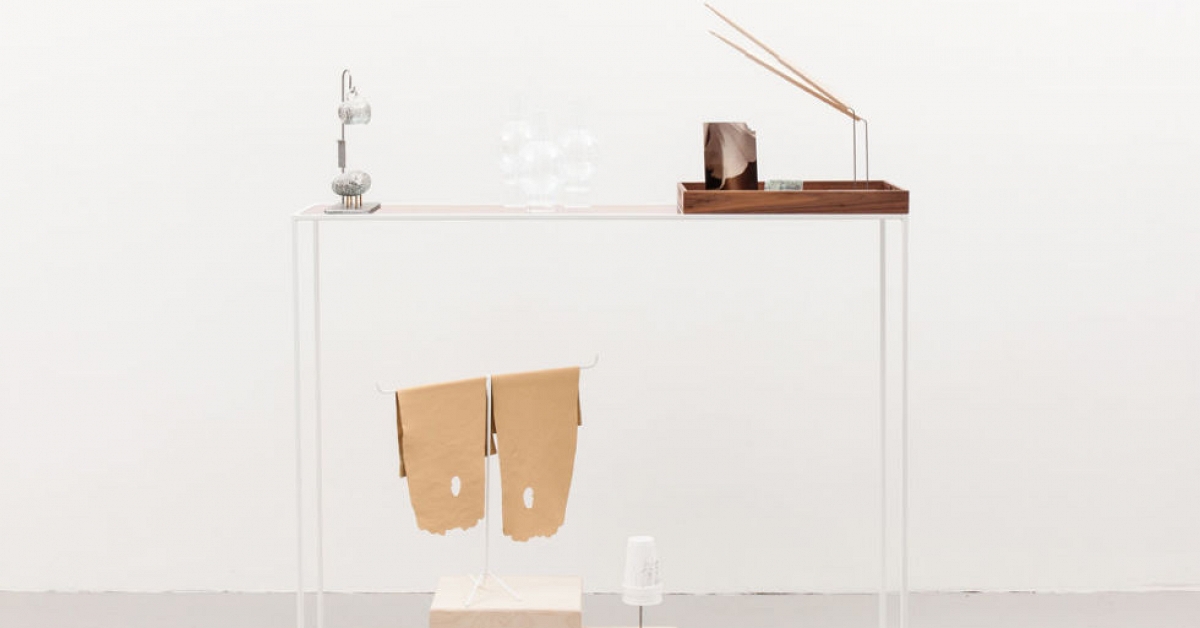‘God Forbid We Should Talk About Joy’: Jennie C. Jones on Dodging Pressure to Signify Blackness in Her Art, and Finding Her Own Language
Artnet News / Mar 16, 2022 / by Taylor Dafoe / Go to Original

Jennie C. Jones at the Guggenheim Museum, 2022. © Solomon R. Guggenheim Foundation. Photo: David Heald.
A visual artist interested in sound, Jennie C. Jones is a composer in both senses of the word.
With their muted palettes and modular configurations, Jones’s works harken back to the postwar abstractions of painters like Barnett Newman and Agnes Martin, who made a virtue of empty space, and pay homage to the Black musical avant-garde of the 1950s, such as free-jazz pioneers who turned strategic silence into a statement.
Jones employs a similar tactic. Her canvases combine elements of both painting and sculpture, but their effect is as aural as it is visual. Often incorporating acoustic panels—her signature material—they shape the sound in the rooms where they’re installed. Don’t expect a profound sonic shift, though. The effect is barely perceptible. More than anything, they invite you to stop and listen, to contemplate the ambient waves of sound already swimming around—and their relationship to the history of minimal aesthetics.
“Listening,” Jones has said, “is a conceptual practice” all its own.It’s a strategy that asks, rather than demands, your attention. Finally, it seems, the art world is tuning in.
On view now at the Guggenheim is “Dynamics,” a mid-career survey of Jones’s output. It’s the perfect setting for such a show, given the museum’s rich collection of Modernist art—also a major interest of the artist’s—and its iconic architecture, which allows for an art experience that sounds, acoustically, unlike any other. The exhibition features canvases, drawings, and other works from the past decade and a half of Jones’s career, as well as several new pieces, including a site-specific audio track that envelops the museum’s spiral with droning tones.
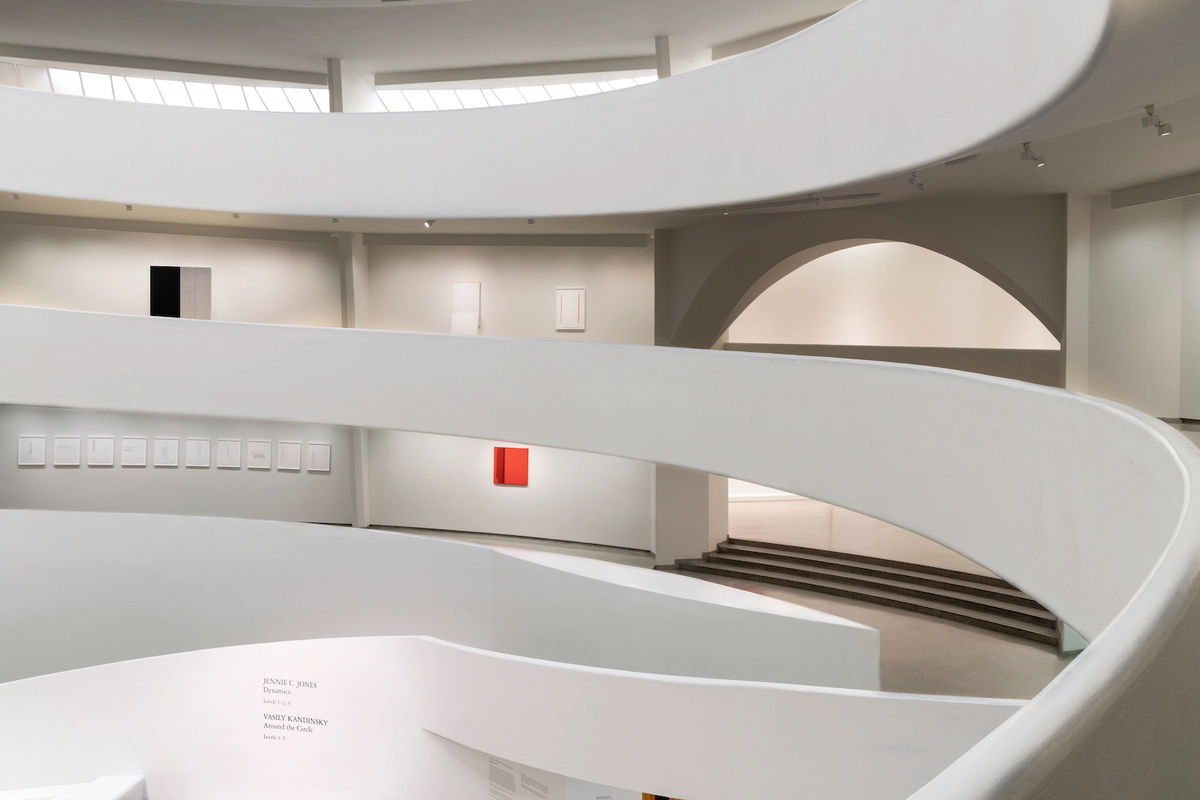
Installation view, “Jennie C. Jones: Dynamics," Guggenheim Museum. Photo: David Heald. © Solomon R. Guggenheim Foundation, 2022.
On the occasion of the exhibition, we visited Jones at her studio in Hudson, New York, where she talked about embracing gesture, John Coltrane, and her own upstream path to recognition.
You often begin talks by showing a photo of John Coltrane at the Guggenheim. Given that your exhibition at the museum is the reason we’re speaking today, I thought that might be a good place for us to start. What does that photo mean to you and your practice?
I started my talks with that photograph in like 2005-ish. I feel like I’m kind of moving on from that, but it’s a really beautiful, cyclical story to say that I manifested an exhibition in the very space that I was pointing to institutional critique. What interested me about that photograph was his gaze, staring directly at the viewer, and then you glance down and he’s pointing at his instrument case in this very assertive way, as if to say, ‘This is my form of art, this is my form of Modernism.’
What was the original context of that photo? Do you know?
When we were first talking, Lauren Hinkson, the curator of my exhibition, sent me other photographs [of Coltrane]. He was just a visitor. I think it was 1953. But it had nothing to do with the work that was up or for an album cover or anything like that. It’s interesting, that kind of interchange between art and music and inclusion and exclusion in narratives around Modernism.
So that was the scene you were setting for your lectures?
It was a specific [way for me to] ask the question, ‘Where am I in this narrative?’ As someone who’s incredibly brainwashed in the deep end of art school, working with a ton of art history from my teenage years, I was looking for myself in these narratives and looking for ways to push against the canon—to critique and engage with it at the same time.
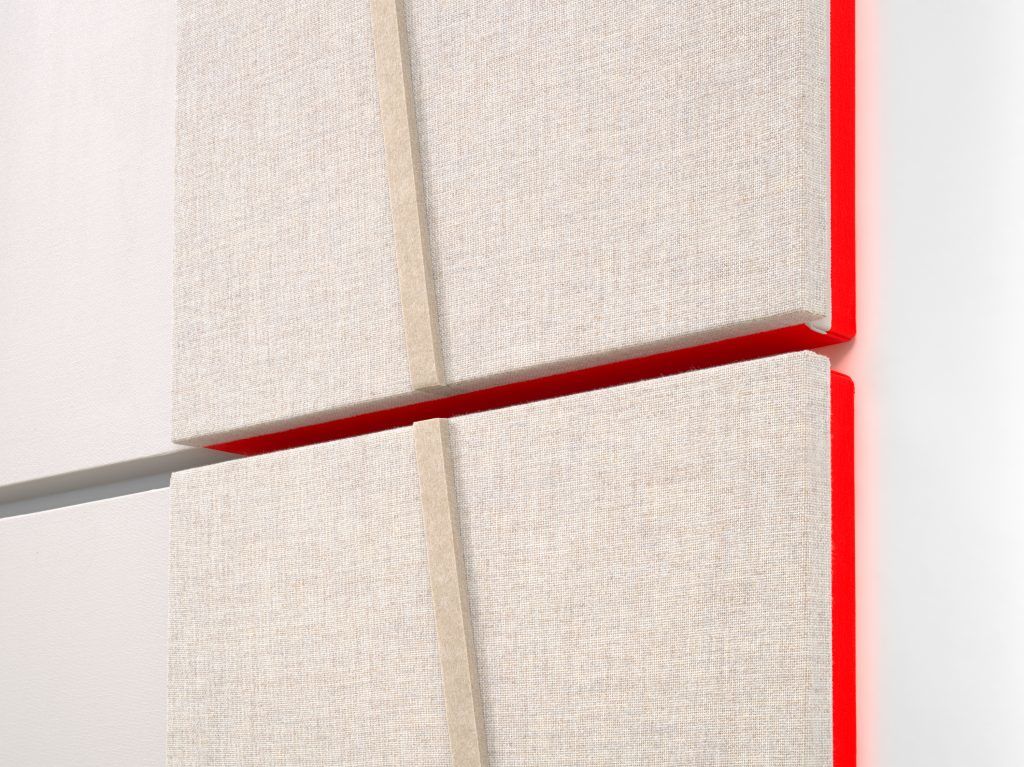
Jennie C. Jones,”¯Fractured Extension/Broken Time”¯(2021), detail.”¯ © Jennie C. Jones. Courtesy of Alexander Gray Associates, New York, and PATRON Gallery, Chicago.
You mentioned your background. I’ve read that you grew up in a creative household?
I think so. It was a very ’70s household. It was free, no shoes, running around. My dad was smoking weed in the garage—that kind of situation. Good and bad free-range parenting on occasion. [Laughs] But my mom was really the cornerstone of the creative energy of our house. She taught Montessori school very briefly. We had lots of literature and music and records in the house. We had a piano, which I quit. Then I wanted to play the violin, which I quit. In a dramatic way, I always say that I wanted to just hide under the dining room table and make drawings instead. But when no one was home I would make up crazy songs on the piano. That was the beginning of the private improvising studio practice.
What kind of music were you exposed to early on?
Definitely a big range. Folk music for sure. Richie Havens, Cat Stevens, Doobie Brothers—that was early. My mom had an extensive interest in jazz and also South American music and samba. Then my brothers—one was into hardcore Rolling Stones rock-n-roll and the other one was hardcore P-Funk, Ohio Players. By the time I was in high school I had processed all of that. So I loved everything from Astrud Gilberto to Crass and Black Flag. Then I was goth for a while, with the depression and the big Flock of Seagulls bangs and [I was into] Cocteau Twins and Joy Division and Morrissey.
When did you start to make visual art?
I don’t even know. Maybe it’s just the last two years! It was a blessing and a curse: I was one of those kids, if you asked me when I was seven what I wanted to be I would say, ‘artist.’ I was lucky enough to also go to a great school system. We moved to the right side of the tracks just enough [for me] to go to the better school district. It was well worth it and incredible, but also isolating and strange, and [there was] not a lot of diversity. By high school I was taking AP art classes. I recently found a paper that I wrote for my English class. The prompt was just to write a compare and contrast. I think I was 15 and I wrote about Fauvism and Cubism. It was basically straight from an encyclopedia, but to think that I was 15 in Ohio trying to figure out these two massive ways of seeing and making work…

Installation view, “Jennie C. Jones: Dynamics," Guggenheim Museum. Photo: David Heald. © Solomon R. Guggenheim Foundation, 2022.
Were you making paintings then? Drawings?
I was making drawings, paintings. I always worked with diptychs and triptychs. It’s funny, I think that’s the only thing that’s gone through all of my work from my teenage years until now. I made a series of still life drawings, sad goth pencil drawings of trees out of my window. Without knowing who Diane Arbus was, I made a graphite image of one of her photographs. I also had a Basquiat locket that I would wear.
Then came undergrad at the School of the Art Institute of Chicago. What were you making there?
SAIC was the most incredible experience and the time period I was there was pivotal. The culture wars and the AIDS crisis and the Persian Gulf War, censorship, Newt Gingrich—there was this hotbed of activity. Coming from Ohio, I arrived with all the single weirdos from all the high schools and we were in one building together. I arrived as a painter and then I was taking body movement classes and learning about sculptural materials and making holograms and [exploring the] performance art department. By the time you graduate you’re supposed to declare your major, but everyone ends up being so interdisciplinary by the time they leave that you’re like, ‘Okay, I guess I’m still a painter.’ So our joke was that everyone should have a t-shirt that says ‘I started as a painter.’
Circling back to painting over the last 10 years has been through that same critical lens, through [my experience with] all these other conceptual ways of thinking and all these other interdisciplinary constructs.

Jennie C. Jones, Neutral [clef] Structure 1st & 2nd (2021). © Jennie C. Jones. Courtesy of Alexander Gray Associates, New York, and PATRON Gallery, Chicago.
Throughout your career, it seems, you’ve often operated at odds with the prevailing trends of the day, embracing abstraction or minimalism, say, when portraiture was popular or Neo-expressionism was preferred by the market. Were you engaging with the ideas at the center of the culture wars when you were at SAIC? Or were you going against the grain even then?
It’s a complicated linear history that we’re all subjected to as makers. I definitely had photo-collage and ripped-from-the-headlines moments, and I was reading my first feminist discourses, reading early bell hooks. Lucy Lippard’s Mixed Blessings had a huge impact on me. It was like all the missing pages in Gardner’s Art Through the Ages [textbook] were dropped on [me] and Lippard just kicked everything open.
That was a time that really shaped me. It also highlighted the pigeonholing that can happen. I think that’s been the hardest thing in terms of finding my own voice and feeling confident in the vernacular and the geometry that I have made for myself. There was still this gravity [to the idea] of Blackness and not being Black enough without figuration or without a signifier. That, unfortunately, is what the market did to my head. Because it’s not popular for a collector to point at something and not be able to have it just immediately read that it was made by a woman or a person of color or by a queer person. If it’s harder and the viewer has to work a little bit harder, well maybe that’s where my high-school, ‘fuck you’ punk rock [stance] comes in. Because now I’m just like, ‘who cares?’ Work a little harder. How many silkscreens or drawings can we have of lynchings and who’s buying them? Why do you want to live with them? You can know that history and not have it be inside of your studio space, inside of your psyche. God forbid we should talk about joy.
We’re going through another moment where identity-based art is hugely popular. Do you wonder if the market is teaching young artists the wrong lessons in the way it did to you?
I was on a panel once and Dawoud Bey was the moderator. He brought up this concept of systems of reward and that really stayed with me. It’s kind of a fiction to [isolate] this one historic moment, but to think about the Harmon Foundation, which [during the Harlem Renaissance] gave the first awards and grants to artists of color. It dictated that you’ll get rewarded for telling your story. But I don’t know. It’s really sticky.
Alma Thomas’s work spoke to me 30 years ago. Carmen Herrera, Howardena Pindell, Mavis Pusey is another one—the art world loves an old lady wheeling into her show when she’s finally at the Whitney. And it’s just heartbreaking. There are people that I think have been courageous and consistent and I can only hope that my foolish consistency was encouraged because of them. You’re not going to make any money, you’re not going to be popular. But my goal is not to be in Architectural Digest and have a Ferrari. It’s to have a garden and make my work. I still need to figure out the garden part.
We’re going through another moment where identity-based art is hugely popular. Do you wonder if the market is teaching young artists the wrong lessons in the way it did to you?
I was on a panel once and Dawoud Bey was the moderator. He brought up this concept of systems of reward and that really stayed with me. It’s kind of a fiction to [isolate] this one historic moment, but to think about the Harmon Foundation, which [during the Harlem Renaissance] gave the first awards and grants to artists of color. It dictated that you’ll get rewarded for telling your story. But I don’t know. It’s really sticky.
Alma Thomas’s work spoke to me 30 years ago. Carmen Herrera, Howardena Pindell, Mavis Pusey is another one—the art world loves an old lady wheeling into her show when she’s finally at the Whitney. And it’s just heartbreaking. There are people that I think have been courageous and consistent and I can only hope that my foolish consistency was encouraged because of them. You’re not going to make any money, you’re not going to be popular. But my goal is not to be inArchitectural Digestand have a Ferrari. It’s to have a garden and make my work. I still need to figure out the garden part.
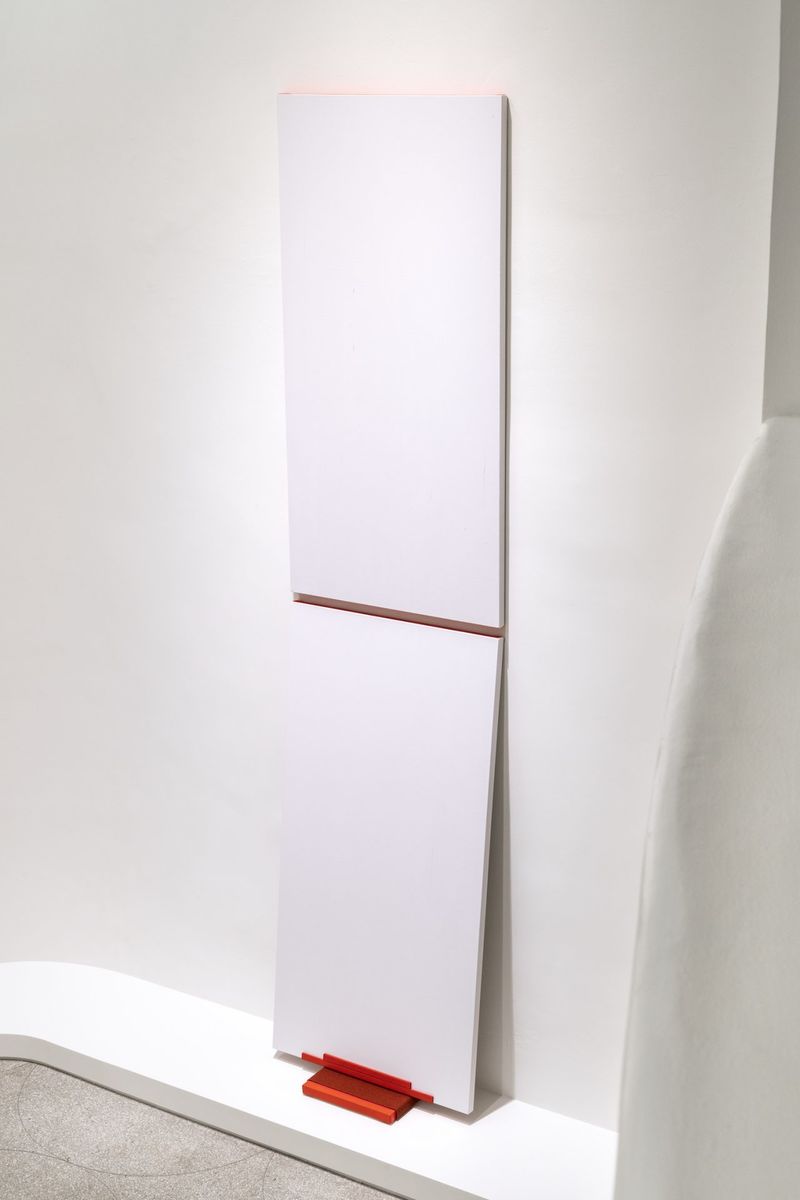
Installation view, “Jennie C. Jones: Dynamics," Guggenheim Museum. Photo: David Heald. © Solomon R. Guggenheim Foundation, 2022.
For a long time, your work has invited a relationship with music and sonics. Initially, you did so by incorporating the physical, often analogue stuff of music production and distribution—things like headphones and speakers, instrument cables, and cassette tapes. That’s a different approach to the one you have now. Can you tell me about this earlier period of your practice?
When I was looking at that early origin story—[that question of] ‘Where am I in this Modernist history?’—music and listening was such a huge part [helping me out] when I was stuck. When I moved to New York, I just felt stuck and I didn’t have a studio. I found that I was spending an enormous amount of time curating what I was going to listen to before I started working. [I was] getting my music together and then would just end up sitting and listening and still being stuck in a way.
Then I realized, ‘Well, this is kind of the work.’ It was kind of a live performance practice and [I started] making drawings that came out of that. Then came the idea of listening as a conceptual practice, which was something that I wrote in my notebook and it just stayed with me.
This period of your output we’re talking about, it was in the late ’90s or early 2000s?
I made my first sound piece around 1999. I wasn’t really getting into the physicality of music then, I was still just making drawings—always paper, always collage, which then led to thinking about graphic scores and seriality.
You began to incorporate acoustic paneling into your canvases around 11 years ago, doing so for the first time in your show at the Kitchen in 2011—and it has become a favorite strategy of yours since. Can you tell me about how you came to that material and what it unlocked for your practice?
It came with a lot of early Googling and research, honestly. [I was] really feeling pigeon-holed and stumped. And a little bit snubbed by galleries—mostly because of scale, because people don’t care about works on paper. [I thought], ‘How can I begin to not just make illustrations around listening and sound and speakers and the physical residue of these things but around how sound is operating in a physical space?’ So I started researching sound-proofing materials—and inside of that, really looking at physics and architecture. In these gallery white-box spaces, you can either push against the architecture or you can lean into it. And leaning into it always works. It’s going to echo, it’s going to drift, so focus on something that’s going to be enhanced by drifting and hitting a cement floor or glass ceiling. How can you start to nuance that?The acoustic panels I found on eBay from this guy who was taking apart his recording studio. I used them for that show at the Kitchen.
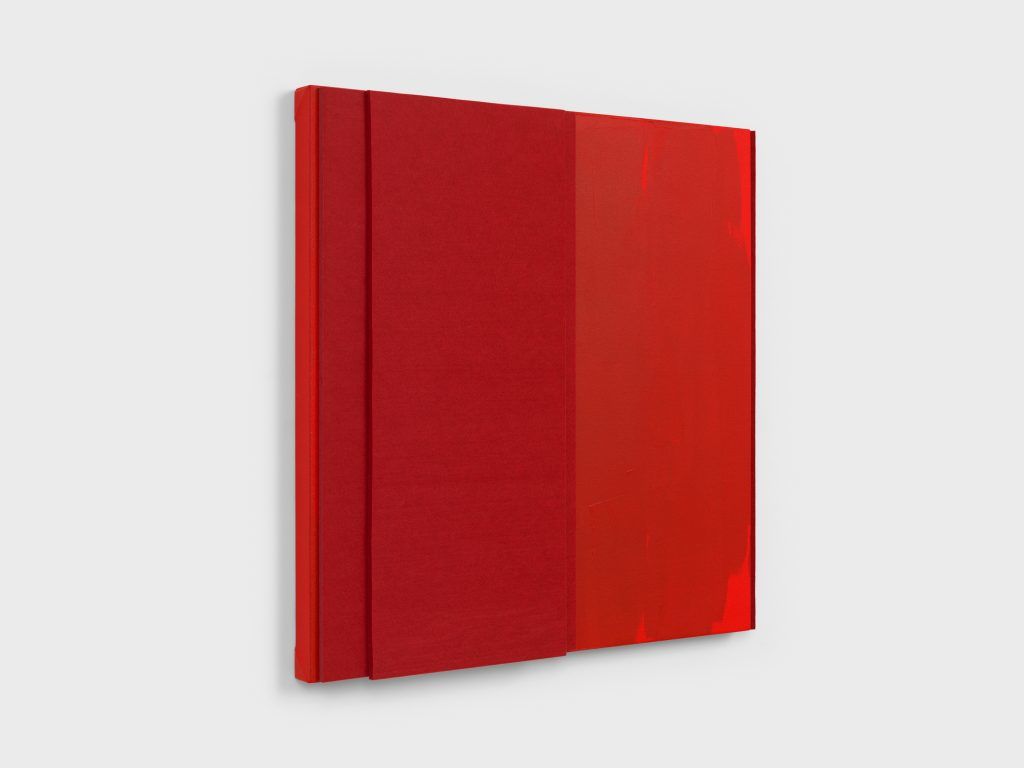
Jennie C. Jones, Red Tone Burst #2 (2021). © Jennie C. Jones. Courtesy of Alexander Gray Associates, New York, and Patron Gallery, Chicago.
It seems like that moment represented an important evolution in how you approached your work too?
The shift was me really going down the rabbit hole of acoustics and physics and architecture, and then inside of that finding connection to music notation and making my own geometry from music notation. It’s like a presence and absence thing for me. Even without sound in the room, the surfaces are working and doing what they’re supposed to do. That’s the shift of thinking of painting as an object versus thinking of painting as a window. Paintings are objects so even without an acoustic panel, they affect the acoustics. More and more I really connected to the metaphor of absorption and diffusion, which are two principles of acoustics. One is to deflect sound and one is to absorb sound in echo-y spaces. That was the title of the Kitchen show, “Absorb/Diffuse.”
Something that’s surprised me about your wall works in recent years—and it’s an observation I had at the Guggenheim show as well—is how present your own hand is. In person you notice gestural marks and imperfections that don’t necessarily come through in pictures.
That’s the push-pull struggle with painting and with gesture. The labor it takes to remove your mark is threefold, and now I intentionally do some work with a knife or [another tool] to create a mark and then the opacity builds from that.
The Guggenheim’s galleries, with their curved, twisted walls, really throws into stark contrast the rectilinearity of your work. That your canvases appear as modular and flat as they do is interesting to me, especially given your interest in jazz and other forms of music that play with structure—or elide structure altogether. Why are you drawn to that way of making?
As much as we try to escape the linear, it is just time. Not to get that metaphysical about it. My exhibition “Constant Structure” was coming from a music term that’s really looking at something that’s a constant flow, and there’s modulation and changes inside of that constant. There is a constant even when you reject reading music, there are still parameters. Inside of improvisation, I would argue that there are still parameters. I think that’s an interesting space to push against, to occupy. It’s confusing and it’s conflicting, to want to talk about modes of liberation and wild expression and then also containment at the same time. But the Guggenheim, that building is incredibly magical in the parameters that it presents. It was completely cool to witness the team there that knows the math of the ramps. Nothing is hung straight because you’re never standing on a flat surface. Each level requires different math and each one of those bays is it’s own. It was fascinating.
This interview has been edited and condensed for clarity. You can hear the full interview in a recent episode of Artnet News’s podcast, The Art Angle.
Click here to listen | The Art Angle Podcast: Jennie C. Jones on Why You Should Listen to Her Paintings
“Jennie C. Jones: Dynamics”is on view now through May 2, 2022, at the Solomon R. Guggenheim Museum in New York.





